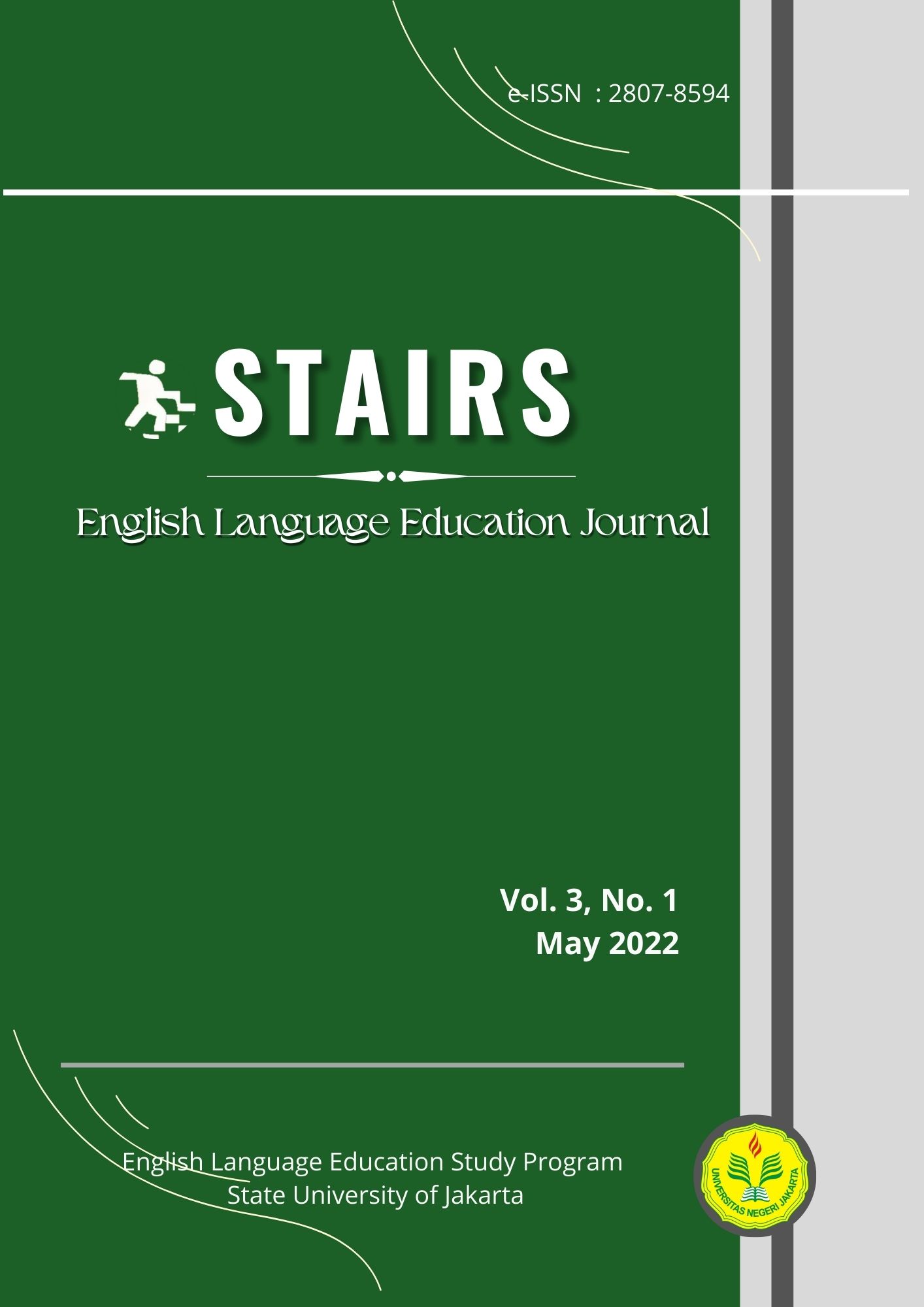The Incorporation of Digital Literacy in EFL Learning Materials for Senior High School Students
DOI:
https://doi.org/10.21009/stairs.3.1.7Keywords:
Digital Literacy, EFL Learning Materials, Senior High School StudentsAbstract
Digital literacy is an important ability to have to succeed in today's era where almost everything is surrounded by digital technologies, tools, services, and so on. This study aims to investigate to what extent digital literacy is incorporated in EFL learning materials for senior high school students, and to describe how digital literacy is incorporated in EFL learning materials. This qualitative study uses content analyses in analyzing the 36 learning materials that have been collected from 4 different public senior high schools in the East Jakarta area from 4 different teachers. This present study found that digital literacy is not yet maximally incorporated into the learning materials. Out of 36 English learning materials, only 16 English learning materials seem to be incorporated with digital literacy indicators, while some others didn't even incorporate digital literacy at all. Digital literacy in learning materials is incorporated in many ways; instruction (43 occurrences), task (31 occurrences), text (8 occurrences), and last is the provision of links (3 occurrences).
References
Ary, D., Jacobs, L., Sorensen, C., & Razavieh, A. (2010). Introduction to Research in Education (8th ed.). Belmont, CA: Wadsworth.
Asrizal., Amran, A., Ananda, A., Festiyed, & Khairani, S. (2018). Effectiveness of Integrated Science Instructional Material on Pressure in Daily Life Theme to Improve Digital Age Literacy of Students. Journal of Physics: Conf.
Azzahra, N. F., & Felippa, A. (2021). Memajukan Keterampilan Literasi Digital Siswa melalui Pemutakhiran Kurikulum Sekolah. Center for Indonesian Policy Studies. Retrieved from https://c95e5d29-0df6-4d6f-8801 d6926c32107.usrfiles.com/ugd/c95e5d_1e0d54119add4a61b6d6cac46bc0c6a4.pdf.
Buckingham, D. (2015). Do We Need Media Education 2.0? Teaching Media in the Age of Participatory Culture. New Media and Learning in the 21st Century, 9-21.
Damayanti, D., Fauzi, A., & Inayati, A.M. (2018). Learning Materials: The “Nucleus” of Language Teaching. Journal of English Education, 3(1), 1-8.
Diana, P. Z., & Wirawati, D. (2020). Analisis Kebutuhan Pengembangan Buku Ajar Komprehensi Lisan Berbasis Nilai-Nilai Islam dan Berorientasi Literasi Digital. Jurnal Pendidikan Bahasa Indonesia, 8(2), 170-179.
Fuqoha, Ananda, P.A., & Nabila, D.A. (2019). Peningkatan Digital Literasi Terhadap Ujaran Kebencian di Media Sosial Melalui Program “Room of Law” Bagi Siswa Sekolah Menengah Atas di Kota Serang. Bantenese Jurnal Pengabdian Masyarakat, 1(1), 9-17.
JISC. (2018). Building Digital Capability: Building Capability for New Digital Leadership, Pedagogy, and Efficiency. Retrieved from https://www.jisc.ac.uk/rd/projects/building-digital-capability.
Karpati, A. (2011). Digital Literacy in Education. UNESCO Institute. Retrieved from https://iite.unesco.org/files/policy_briefs/pdf/en/digital_literacy.pdf.
Kementerian Komunikasi dan Informatika Republik Indonesia (Kominfo RI). (2018) Jumlah Pengguna Internet 2017 Meningkat, Kominfo Terus Lakukan Percepatan Pembangunan Broadband. Siaran Pers No. 53. Retrieved from https://kominfo.go.id/content/detail/12640/siaran-pers-no 53hmkominfo022018- tentang-jumlah-pengguna-internet-2017meningkat--kominfo-terus-lakukanpercepatan-pembangunan-broadband/0/siaran_pers/ kominfo/02 / 2018.
Mudlofar, A. (2012). Aplikasi Pengembangan Kurikulum Satuan Tingkat Guruan dan Bahan Ajar dalam Guruan Islam. Jakarta: Rajawali Pers.
Murtafi’ah, B., & Putro, N. H. P. S. (2019). Digital Literacy in the English Curriculum: Models of Learning Activities. Acta Informatica Malaysia, 3(2): 10-13.
Ocak, G., Ozcalisan, H., & Kuru, N. (2010). The Student Attitudes in Terms of the Usage of English Activities and Materials and Their Contributions to the English Learning Process. Procedia-Social and Behavioral Sciences. Vol. 2, 560-564.
Perdew, L. (2017). Information Literacy in the Digital Age. Minnesota: Abdo Publishing.
Purnamasari, L., Kartini, H., Distrik, I Wayan., & Doni, A. (2021). Students’ Digital Literacy and Collaboration Abilities: An Analysis in Senior High School Students. Indonesian Journal of Science and Mathematics Education, 04(01), 48-57.
Spires, H. A., & Bartlett, M. E. (2012). Digital Literacies and Learning: Designing a Path forward. Friday Institute White Paper Series, 5.
Techataweewan, W., & Prasertsin, U. (2017). Development of Digital Literacy Indicators for Thai Undergraduate Students Using Mixed-method Research. Kasetsart Journal of Social Sciences.
Wakhidah, L. N., Sunismi, S., & Alifiani, A. (2020). Pengembangan Bahan Ajar Berbasis Literasi Digital dan Kompetensi Abad XXI Pada Materi Barisan Kelas XI. Jurnal Penelitian, Pendidikan, dan Pembelajaran, 15(33).
Western Sydney University. (2017). Library Study Smart Digital Literacy. Australia.



